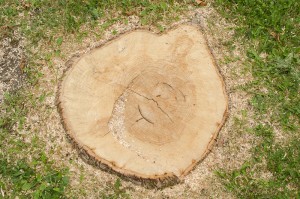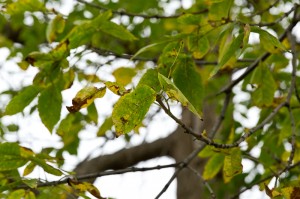It’s a bright Saturday morning when the green ash trees start to fall at Carleton University.
With a cracking boom the trees hit the ground, brittle, dead branches breaking or bending with the fall.
The tree removal crews, clad in hardhats and fluorescent vests, move in and start slicing off the tree’s limbs with chainsaws. They drag them up to the large wood chipper, and the machine shreds the once-living wood.
Already rows of dead ash trees have been replaced by rows of barren stumps. All over campus, the skeletons of once healthy trees are being brought down. The stumps can be seen along the entrance to campus, behind Residence Commons, by the bus stop near athletics—all over campus.
By the time the caravans of first-years have arrived on campus, Carty’s Tree Service will have taken down 129 ash trees. The cost of this round of removals is $5,073, according to Mike Graham, assistant director of Facilities Engineering and Construction. More will need to come down in the following years.

The dead trees show no visible signs of damage except for their peeling bark. Beneath that protective rind are aimless twisting tracks of destruction left by the larvae of the emerald ash borer.
“It’s such an abundant species for this area, it’s easy for this lazy flying beetle to travel. It doesn’t have far to go,” James Carty, owner of Carty’s Tree Service, said.
“And the bug came in so fast, we didn’t realize until it was too late,” he added. Uninfected ash trees can be saved by treatments of insecticide injected under the bark. It’s expensive, costing hundreds of dollars per tree, and it only works if the tree hasn’t been completely infected already.
The tiny green beetle, native to Asia, arrived in eastern Ottawa a few years ago and has since decimated the city’s green ash population. Ash is a popular tree species in Ottawa, Carty said. The species is fast growing and easy to care for he said. Some neighbourhoods in Ottawa contain ash almost exclusively. But ash trees are extremely susceptible to to the emerald ash borer.
“Lots of the city parks, the natural forested areas, is ash,” Carty said. And there’s a time limit on removing dead ash trees safely, before the trunk and limbs decay too much to allow arborists to climb them and cut off their branches.
“In many parts of the city, including government areas, you can’t even climb the trees anymore they’re in such decline,” Carty said.
“They’re very aggressive growers,” he said, of ash trees. “They take well to pruning, they just don’t take well to the bug.”

Carty said ash trees make up such a large part of Southern Ontario forests because many were replanted to replace elm trees that succumbed to Dutch Elm Disease in the ’60s and ’70s. Now those replaced ash trees are also the victims of decimation.
“My company in the past year has probably removed 250-300 trees. . . directly because of the bug,” Carty said.
Carty said Carleton made the right choice in having the trees removed now.
“Carleton did something about it. They had us come in there before some of the trees became dangerous. They’re going to keep doing that . . . so that they’re safe to work with and they don’t injure any students,” Carty said.
Carty said he was told Carleton’s campus contained about 500 ash trees. Tree removal will likely be a necessary task for several more years at Carleton.
The university will be replanting to replace the lost tree coverage, but the details of this plan aren’t clear yet, said Graham.
Even when new trees are planted, it will take years before they can provide the shade that the older trees did. Those trees range from 20 to 60 years old, according to Carty. One large tree removed from the university quad could have been as much as 80 years old.
But the old trees will find a second life of sorts on campus. The newly made wood chips and the cut logs will be used by the Graduate Students’ Association’s new community garden, located near the P6 parking lot.
The wood chips from the shredded ash limbs will be used for mulch on the garden beds, said Chris Bisson, the community facilitator of the garden.
“We also have a number of logs that we’ve collected which we’ll be also using,” Bisson said. “The ash chips will not be going to waste.”
They plan to bury the logs in soil and allow them to slowly compost, adding to the fertility of their garden beds.
“Unfortunately I guess when all the ash trees were put in place they didn’t plan to have much biodiversity of trees,” Bisson said.
“It’s unfortunate to see all the ash trees go . . . they’re gorgeous,” he added.






